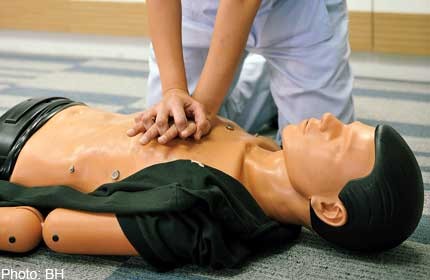Cardiac arrest more common in young than thought


Using 30 years of data from King County in Washington, researchers found that the rate of cardiac arrest among children and young adults was about 2.3 per 100,000 each year.
That's not a big risk. But the figure is substantially higher than the "widely accepted" estimate for young athletes (not just young people in general), said senior researcher Dr. Jonathan Drezner.
According to that estimate, one in 200,000 young athletes (up to age 35) suffers cardiac arrest each year.
Cardiac arrest occurs when the heart suddenly stops pumping blood to the rest of the body. It is fatal within minutes without immediate treatment.
A major cause of cardiac arrest is ventricular fibrillation, where the heart's main pumping chamber starts to quiver chaotically. A device called a defibrillator can "shock" the heart back into a normal rhythm - though even with treatment, cardiac arrest is often deadly.
The good news from the current study is that young people's survival of cardiac arrest got much better over the 30-year period. It rose from 13 per cent in the 1980s, to 40 per cent between 2000 and 2009.
"It's very gratifying to see that our efforts are paying off," said Dr. Dianne L. Atkins, a pediatric cardiologist at the University of Iowa in Iowa City.
Research over the years has allowed experts to figure out the best way to perform cardiopulmonary resuscitation (CPR), and public campaigns have been done to encourage more people to learn CPR.
CPR cannot "restart" the heart, but it can keep blood and oxygen moving through the victim's body until medical help arrives.
"Learn CPR and be willing to do it," said Atkins, who wrote an editorial published with the study in the journal Circulation.
The true rate of cardiac arrest among kids and young adults has long been debated.
Drezner said he thinks his team's findings come closer to the "real" figure than most past studies, because of its methodology.
The findings come from a cardiac arrest database kept by King County in Washington State. Emergency medical services report all cases of cardiac arrest to the registry.
Drezner's team also used other records, like autopsy reports and hospital records, to try to figure out the cause of each cardiac arrest.
Between 1980 and 2009, there were 361 cases of cardiac arrest logged for children and adults age 35 and younger - including 26 toddlers under 3, most of whom had congenital abnormalities.
That amounted to a rate of 2.28 cases for every 100,000 young people each year.
Atkins agreed that this study gives a clearer picture of the true incidence of cardiac arrest in young people. "It's the best data we have."
And, she said, researchers should know how common the problem is before widespread screening programs, if any, can be put in place.
The idea of screening kids for heart problems that could cause cardiac arrest is controversial. Some countries, including Italy and Israel, have mandatory electrocardiogram (EKG) screening for young athletes. The US is not one of them.
For now, Atkins suggested that parents be aware that cardiac arrest can strike children -- but also keep the risk in context.
"It is still a very uncommon event," she said. "I don't think the message is that parents should be so frightened that they don't let their kids go out for competitive sports."